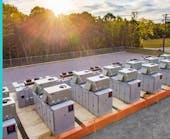Jaguar Land Rover Developing Energy Storage Systems from Used EV Batteries
In collaboration with Wykes Engineering Ltd, Jaguar Land Rover (JLR) is developing battery energy storage systems (BESS) in the United Kingdom to harness solar and wind power by utilizing used electric vehicle (EV) batteries. Each BESS will deploy 30 second-life Jaguar I-PACE batteries taken from prototype and engineering test vehicles that can store up to 2.5 MWh of energy at full capacity.
Each BESS, which is linked to an inverter to maximize efficiency and manage energy, will also be able to supply power directly to the National Grid during peak hours as well as draw power out of the grid during off-peak hours to store for future use.
“One of the major benefits of the system we’ve developed is that the containers are connected to the Grid in such a way that they can absorb solar energy that could otherwise be lost when the grid reaches capacity,” said David Wykes, Managing Director of Wykes Engineering. “This excess energy can now be stored in the second-life I-PACE batteries and discharged later. This allows us to ‘overplant’ the solar park and maximize the amount of power we generate for the area of land we are using.”
The partnership represents a critical step in JLR’s adoption of circular economy principles, which is part of the company’s plans to achieve carbon net zero by 2039. Once the health of the batteries deteriorates below the required level for second-life use cases, JLR will recycle the batteries to recover the raw materials for re-use.
“We’re delighted to be working with Wykes Engineering on this pioneering project that will help unlock the true potential of renewable energy. Developing second-life battery projects like this is crucial to helping JLR adopt a new circular economy business model and drive us toward achieving carbon net zero,” said Reuben Chorley, Sustainable Industrial Operations Director at JLR.





